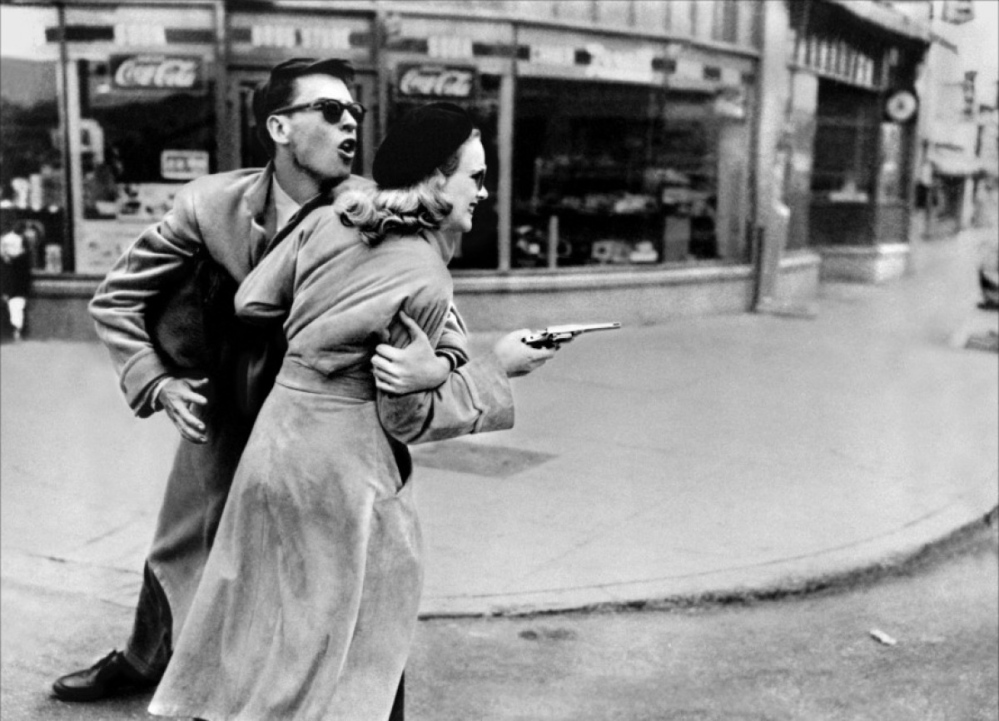When “Gun Crazy” opened in 1950, it was known as “Deadly is the Female.” It flopped. Years later, it kept popping up on little screens and survived. Today it’s known as one of the great examples of film noir.
More on that later.
The story is a simple one: Boy meets gun, boy meets girl who meets gun, boy and girl become bank robbers. Boy and girl reap the wild wind.
It sounds like the story of Bonnie and Clyde, which happened in real life in the 1930s. It’s so much more. Director Joseph L. Lewis, who went on to direct television Westerns, made sure of that.
The story: In flashback, young Bart Tare (a young Russ Tamblyn), obsessed with guns from an early troubled and impoverished childhood, steals a gun from a store, does four years in reform school, four years in the army in World War II and comes home as big Bart (John Dall) to start a fresh new life. But his passion for guns is forever. He has two straight-arrow friends who grow up to be a newspaper editor and sheriff. He will need them, use them and finish his life with them.
But fresh home, he joins them at a carnival, where we meet blond bombshell Annie Laurie Starr, (Peggy Cummins) who does three sideshows a night as a cowgirl clothed sharp shooter.
Bart, whom we know by now is just as good, challenges her to an onstage duel. He wins. They pair up, much to the chagrin of her huckster boss (an oily Berry Kroeger) and take off to a touring life with big dreams that don’t come true.
But luck, in a very dark mask, is with them. Our ambitious Annie is loaded with Lady MacBeth genes. Our Bart, never truly a bad boy, just incurably naive, is sucked into her Shakespearean web, and with eyes blinded by love, and not a little sexual lust, goes along on her scripted journey into the bank robbing business.
Our Bart, still a good farm boy at heart who never killed anything in his life, still refuses to kill. But our Annie, whose soul and heart are darker than her mascara, has no such scruples. Sooner or later, in their last big job, robbing a major meat packing company payroll, she kills two employees, and now, as an accomplice, the hapless but sweet Bart’s picture is lifesize on the front pages along with Annie’s. The finale, in an excellent studio back lot swamp, is, but for one action, predictable.
Dall, who became better known for his role opposite Farley Granger in Hitchcock’s “Rope,” was a successful Broadway actor and went on to make several good movies, including “Spartacus” and “The Corn is Green.”
Cummins became best known for “Gun Crazy” and went on to make dozens of small forgotten films and then went back to her native England.
There is so much history to the film noir genre that it took more than a hundred books to cover it all, and even those missed a lot. Many younger moviegoers, especially in smaller venues like Maine’s film festival, don’t know all that much about the style. Younger generations, those in their 20s and 30s, even up to those in their 50s, consider it only the era of “those old black and white movies,” the ones with corny dialogue and cliche relationships, which is like saying Georges Seurat was the guy who painted colored dots.
Of course it’s so much more than that. It’s one of American films’ great genres. It spawned some of our greatest writing, directing and acting talents: Hitchcock’s “Vertigo,” Orson Welles’s “Lady From Shanghai” and Billy Wilder’s classic “Sunset Boulevard.” But deep down in the bushes of that great movement, we find some we don’t know that much about until we look at their later careers, all of which were intertwined with the explosive political storms of their times.
Ken Eisen, who puts together Maine International Film Festival’s list, is one of the best informed scholars of film noir history. To this year’s MIFF audiences, he brings Millard Kaufman’s “Gun Crazy,” a gem of an example of those great classics and a real treat for its fans.
Kaufman didn’t really write the original script. He fronted for the heroic Dalton Trumbo who was blacklisted, and who got the original story from a magazine story by MacKinlay Kantor, who wrote the story for the great American movie “The Best Years of our Lives.” Kantor also co-wrote “Gun Crazy” with Kaufman.
Thanks to Eisen and MIFF, this historic era and genre lives on. How lucky we are to see it revived.
J.P. Devine is a former stage and screen actor.
Send questions/comments to the editors.




Success. Please wait for the page to reload. If the page does not reload within 5 seconds, please refresh the page.
Enter your email and password to access comments.
Hi, to comment on stories you must . This profile is in addition to your subscription and website login.
Already have a commenting profile? .
Invalid username/password.
Please check your email to confirm and complete your registration.
Only subscribers are eligible to post comments. Please subscribe or login first for digital access. Here’s why.
Use the form below to reset your password. When you've submitted your account email, we will send an email with a reset code.